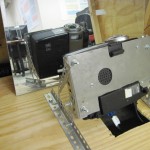Lessons learned from the first FTIR surface
As work moves forward on a new multi-touch surface I think it would be good to explain why we need to build a new one. Although a lot of thought and effort went into our first multi-touch surface there are several problems with it that prevent it from being very usable (or at all usable).
1) Projector mounted at odd angle to compensate for incorrect mirror
 First up is one of the last challenges we had to face to get the table operational, actually getting an image from our projector reflected off an angled mirror upwards to the surface at the correct size and with minimal distortion. The calculations were actually beyond us for the most part so we resorted to building an adjustable rack system to hold the projector in place so we can tweak it until we found an angle that worked.
First up is one of the last challenges we had to face to get the table operational, actually getting an image from our projector reflected off an angled mirror upwards to the surface at the correct size and with minimal distortion. The calculations were actually beyond us for the most part so we resorted to building an adjustable rack system to hold the projector in place so we can tweak it until we found an angle that worked.
The biggest problem, however, is one that we did not see coming. Thanks to Dr. Bob Price in Physics I now know that standard mirrors (like the bathroom mirror we bought from Menard’s on this project) reflect light at certain angles more effeciently than at other angles. Which means that although we originally were pointing our projector at the mirror at the ‘correct’ angle in the beginning we were getting no image because the mirror was not reflecting the light very well. We misinterpreted this as being a problem with our angle and began building the adjustable rack system.
2) Projector gets too hot and turns off
Another issue that we didn’t anticipate is the amount of heat that accumulates inside the enclosure when everything is turned on. Our projector outputs a LOT of heat (the bulbs inside of them can get ridiculously hot) and at first there was no ventilation to deal with it. As a result we could run the projector from cool initial conditions for about 10-15 minutes before the auto-shutdown mechanism in the projector turns it off.
Since we first noticed this problem we though adding some airflow would solve the problem so we ordered 2 360mm silent fans and installed them onto opposite sides of the table. One was mounted on the bottom and drew in air while the other was mounted near the top and blew out air so there was some sort of airflow inside the enclosure. As it turns out though, not enough airflow as the projector still turns itself off after about 20 minutes.
3) Blobs are too dim to be useful, even in low-light conditions
Finally the most important problem we are having with our surface is that the blobs (illuminated fingers) are very, very dim. So dim that almost any amount of ambient light or sunlight overpowers our webcam and makes it very difficult to identify features. Which is odd because we used 850nm IR LED strips from Environmental Lights and an 850nm lens on our webcam which is supposed to eliminate problems from sunlight.
I think the LEDs are the main source of problems, specifically that they are not powerful enough. We lined every edge of our EndLighten acrylic with these LEDs which should be an ideal scenario for FTIR setups and still our blobs are very dim.